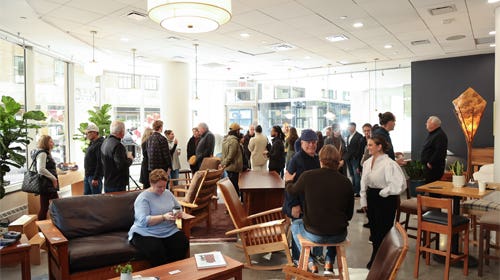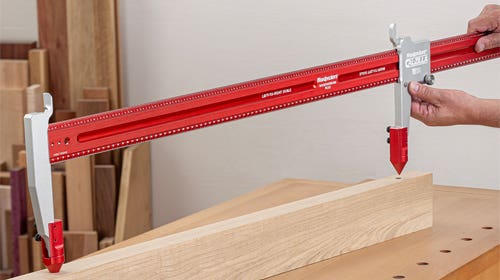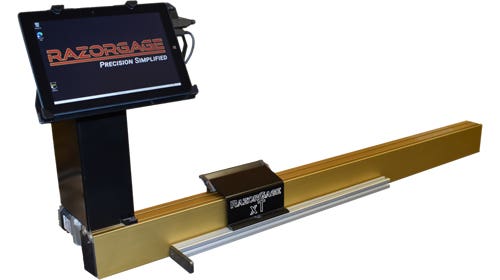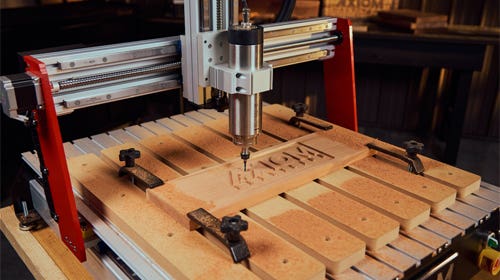AWFS Vegas able to find silver linings
Established in 1911, the Association of Woodworking and Furnishing Suppliers is approaching its 100th anniversary. The association has been through the best of times and the very worst. This year’s…
Established in 1911, the Association of Woodworking and Furnishing Suppliers is approaching its 100th anniversary. The association has been through the best of times and the very worst. This year's AWFS Vegas fair in July illustrated that the AWFS has built and sustained a solid foundation. While attendee and exhibitor turnout was significantly lower than previous fairs, participants - exhibitors and attendees - held their heads up as they trudged along.
{loadposition position10}
The biennial fair itself is 52 years old and, in more recent years, previous attendance averaged about 16,000. Though final numbers were still being tallied in the weeks after the show, officials report the attendance dropped by about 50 percent, to between 8,000 and 8,500 attendees. The exhibitor count dropped about a third compared to previous shows to 580.
Angelo Gangone, executive vice president of the AWFS, says there were no presumptions on turnout given the unusual economic circumstances.
"There were no expectations this year. This year was so unlike any other year - it was a totally different animal. To compare this year to any other year is doing this show - and any other show - an injustice," says Gangone.
The first day of the show, which was held July 15-18 at the Las Vegas Convention Center, was slow and disappointing to exhibitors, but things turned around Thursday when tool and machinery booths were bustling with many browsers and some buyers. Whether professionals or hobbyists, these eager patrons roamed the show floor from booth to booth, experimenting with and mulling over new product purchases. Products ranged from hand tools and woodworking supplies, benchtop and stationary machines, job-site-specific tools, hardware, CAD/CAM software and CNC machines.
Attendee perspective
This was the first AWFS Vegas fair for Jim Cain, owner of JSP Woodwork in Crafton, Pa., a nine-person shop, who has been a regular at the biennial International Woodworking Fair in Atlanta.
"I came here because things are bad with the economy and I'm looking for a deal," Cain says, adding he was specifically looking for a belt sander. "I think everybody is being cautious."
Donald Romans of Ocean Mist Building Co. in Morro Bay, Calif., whose company specializes in custom cabinets, was looking for the latest technology to help him build furniture and cabinets more efficiently. He particularly wanted to find finishing solutions to save time in the shop.
"I'm doing custom work and if I can save an hour a day and cut down on waste, that would be great. I'm amazed at all of the products, but I'm still looking before I buy," says Romans.
Craig Posey, of Ken's Cabinets in Santa Cruz, Calif., went to the show to look around and get new ideas. He wanted to see what the fads were, particularly with veneer and hardware. When asked if he believed some of the marketing pitches about the latest and greatest hardware, for example, his response made him sound convinced.
"If about 20 companies have a similar idea, they wouldn't push it if it didn't sell," Posey says.
Tom Kelly, of WUD Pro in Murrieta, Calif., is now retired from his business and does woodworking as a hobby. He commented on the irony that, while professional business owners are nervous about spending their money, he felt it was worth it to spend on innovative products.
"I'm here looking for new technology and new things to make my life easier," he says. "SawStop is a good example. They made a good point that it costs more to send someone to the E.R. for losing a hand. Liability is a risk in business. I'm worried about safety. Even as a hobbyist, I don't want to work with half a hand."
Exhibitors' viewpoint
Exhibitors naturally marketed their products in Vegas more aggressively than they have in other years. At Martin Machinery, for example, booth deals were about three times higher than they typically are. But even with discounts and deals, some companies didn't sell well. One exhibitor glumly reported no sales had been made by the last day of the show. About the only booth that was bustling up until the closing bell was a seller of remote-control helicopters and most of the buyers were homesick exhibitors.
Ron Porinsky, a representative with Vaculex lifting systems, says he experienced a positive show and believed it was because his product is more diverse than one that specializes only in woodworking. The lifting tools can be useful in other industries where warehouse lifting is required. That presents the opportunity for the company to sell the product at other shows and fairs outside of the woodworking realm. As a result, the company was able to offer even higher discounts, ranging from 10 to 15 percent at the show.
"The decision everyone has to deal with here is based on choosing luxury over necessity. This product might seem like a luxury, but what it does is it eliminates the risk of personal injury which often leads to workers' compensation cases for the employer. We try to explain that, but people just want to save money thinking it's not going to happen to them," says Porinsky.
But not all manufacturers sell from the show floor, so it's difficult to gauge the buying activity at the show. SawStop, for example, only sells through its distributors.
Nevertheless, SawStop's booth was extremely busy as crowds gathered to watch the hourly demonstration of its saw-blade braking device.
"I was very pleased with the exhibitors - they had fantastic attitudes. You would think after such a difficult year people would be down and it would be gloom-and-doom. It was the exact opposite. The optimism was a lot more than I expected," says Gangone.
"There were definitely people shopping for machinery and supplies - people were selling, which was good. The important thing about the show was that it had a good feel to it in a sense that many people may have thought this may be a spark that the industry needs in a time like this when the industry has been decimated."
Show highlights
Features that kept the fun and camaraderie going at the show included the belt sander races and the Fresh Wood Student Competition, which featured work from high school and post-secondary students across the United States and Canada. The Sequoia Awards, another regular show feature, gave exposure to companies that introduced new and innovative products.
"I believe that the Sequoia Awards lent to the show in the fact that you're looking at new products, new technology and new supplies. The main reason people still come to the show is really to see what's new. That's still No. 1, regardless of economic circumstances," says Gangone.
Industry associations participated in the show as well, including the Wood Machinery Manufacturers of America with its offer for a reduced Forest Stewardship Council certification with a membership in the trade group.
In the education category, WoodLINKS U.S.A. representatives actively spoke with prospective school representatives at its booth. The organization is best known as an industry/education partnership designed to promote woodworking as a vocation in high schools throughout the country.
Each show year, the AWFS tries to add something to make the show unique. The Green Desk, where attendees could ask questions related to environmentally friendly practices and issues, and CNC smartSHOP demonstrations had successful debuts. Gangone says stadium seating may be added for the smartSHOP demos at the next AWFS to better accommodate the crowds.
Gangone asserted the AWFS is proud to have pulled off the show given the circumstances. He is looking forward to the centennial celebration of the AWFS at the 2011 AWFS fair.
"I really believe we're going to have better days. I don't think they're that far off. That's the great news."
For information, visit www.awfsfair.org.
This article originally appeared in the September 2009 issue.







